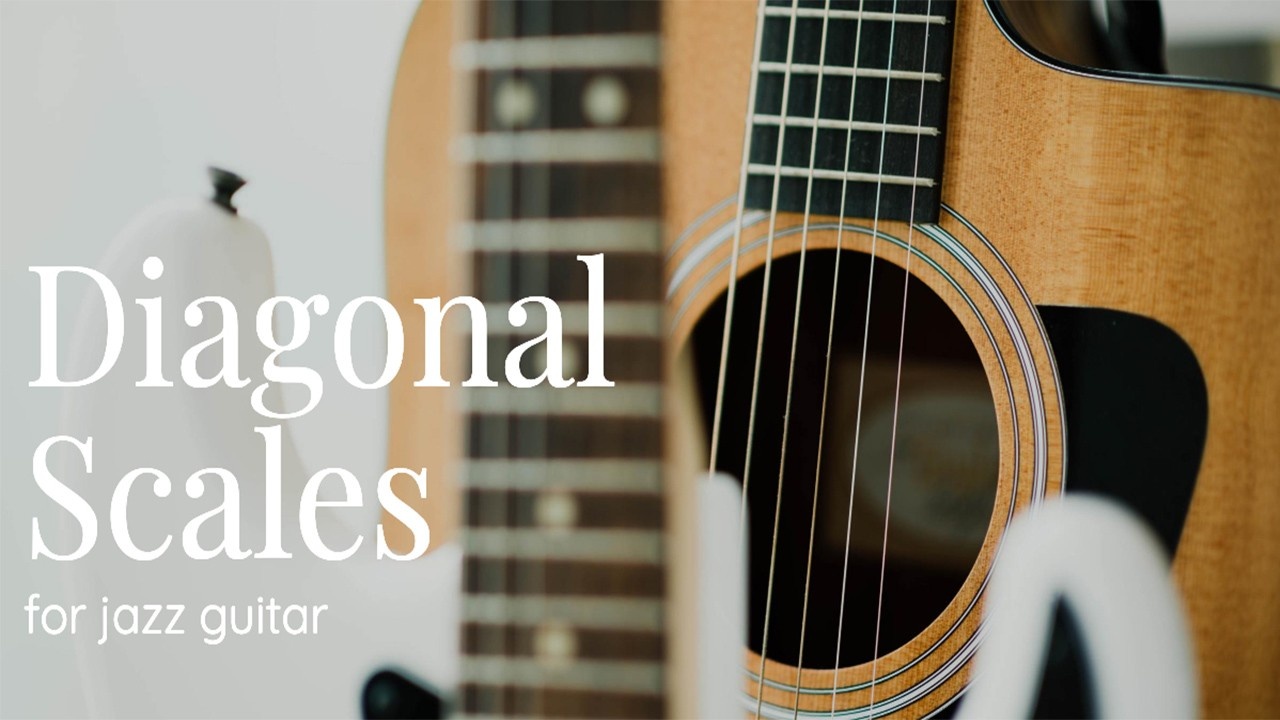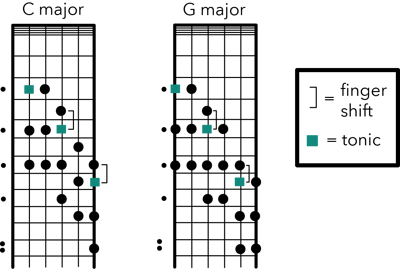
Diagonal Scales for Jazz Guitar
Nov 04, 2020Lesson in Diagonal Playing for Bebop Guitarists
Are curious about the so called bebop scale. Maybe you've heard about scale positions on the guitar or the CAGED system. You may already be a complete master of scales on the guitar. Or perhaps you're just a total beginner (in which case you should check out how to play the major scale first.)
No matter where you stand, here's something to improve your jazz guitar playing: a new perspective! I now offer you this "other solution" for smooth phrasing and bebop melodic lines on the guitar (for jazz improvisation.) This approach is largely underrated and little known (I think), yet it yields enormous potential ...
And it works for many jazz guitar greats (watch them on Youtube), for me and most of my students!! I'm sure you find it interesting. Ready?!
The "Secret" to Jazz Guitar Lines —Diagonal Scale Motion
The secret to amazing linear jazz guitar phrasing in your improvised solos: is to play up-and-across-the-neck (AKA diagonal playing). It is, in fact a blend, between single string (horizontal) and position (vertical) playing concepts.
Here's how it works:

So the term "diagonal" merely means to play up AND across the neck at the same time. It is done by playing 3 or 4 notes on each string while shifting up (or down) the fingerboard. It is different from scale positions only in the fact that we basically play more notes on each string before moving to the next. The ensuing motion of the fretting hand is thus diagonal.
This comes in extremely handy to play fast lines within the bebop scale :-)
This approach to playing jazz guitar scales personally changed my hearing over the years. It is a powerful yet underestimated tool.
Why?
Dig this: Most instrument have only "one way" to play a certain scale. If you play C major scale ascending on a piano for instance, you'll use fingers 123 - 1234 then use the same fingers on the next octave. Which means that on the piano, you use the same physical motion to produce the same sound, in every register of the instrument. "Do-re-mi" on the low keys can be executed with the same muscles and movements on the highest keys.
Now try this on the guitar: C major in seventh position. The LH fingerings are : 24 124 13 ... then the next octave: 4 234 24 1 (2). And you wonder why it's hard to learn and memorize fingerings for scales and arpeggios on the guitar!?! It's chaos!
Diagonal scales on the guitar allow the kind of piano-like evenness we are looking for on the fingerings fretboard, especially for 8-note bebop scales. You'll find yourself using the same fingerings on 2 or even 3 different octaves. Start practicing them and you'll hear and see what I mean.
Comparison / Explanation
Here are the nuts and bolts of jazz guitar scales in diagonal playing in comparison with positions:
Position playing (CAGED) characteristics...
- Restrict the left hand: doesn't move up/down the neck while playing
- Learn the same scale in many different positions (boxes)
- Each note in the scale can be played in many locations
- Usually, 2-3 notes on each string
- Also implies: if you know every (12) major scale in 7 positions, it means that you can stay in one position and play in 7 major keys.
Diagonal playing characteristics...
- Free the left hand: now it does move up/down the fretboard
- Learn any bebop scale in one specific way, diagonally
- Each note of the scale is played in only one location
- Usually, 3-4 notes (or more) on each string (may require shifting)
- Also implies: you know every (12) major scales in one specific way and you're less likely to forget the fingerings...
The main advantages of this scalar diagonal approach:
1. Wider range it covers
Position playing gives about 2 octaves while diagonal goes up to 3 octaves.
2. Evenness of phrasing
Fingerings repeat themselves on each octave. Every note has only one exact location. Guitarists can "play by sound and feel" rather than "by finger and eye".
Other areas of jazz guitar playing (and jazz guitar scales) also helped by diagonal playing :
- Knowledge of fretboard
- Speed/virtuosity
- Bebop scales become easy ;-)
- Reading (only one location for each note!)
- Better LH technique
- Better "finger to ears" relationship
- Easy (very easy) octave transposition
- Ease of learning/memorizing scales and modes
- Range of melodic lines (above 2 octaves)
- Playing in octaves (like Wes)
And finally, before we start... (my fifty cents)
Honestly, I still don't understand why this approach to jazz guitar scales is not more widely discussed and taught. The vast majority of jazz guitarists I know (students of mine, colleagues, teachers, etc.) know and rave about positions playing (and/or the CAGED system) but barely even mention the diagonal approach (if they know about it at all) ...
It's funny though: most influential jazz guitar legends (of past and present times) mix and match single string, positions and diagonal concepts in their solos.
Ready for Jazz guitar scales exercises now? Let's go!
Major Scale played Diagonally
The keys of G and C are used as models here: We clearly "see" the diagonal motion starting on 5th and 6th strings.

Note: Start the scales with fingers 1-2-4 (NOT fingers 1-3-4)
Some Guidelines for Jazz Guitar Scales
#1 - Stretch Between Middle and Ring Fingers
Stretch between first and second fingers. Don't move the entire hand: simply "reach out" with the index while the left hand stays.
#2 - Shift with Index
The shifts (slides) are performed with the first finger between half-steps.
#3 - Break the Rules
In other scales/modes you may have to stretch between third and fourth fingers and/or to shift with the fourth finger.
-In General-
It's all about the hand "staying" while the outside (1st and 4th) fingers "stretching" and "shifting". Experiment and you will find your way of doing it comfortably.
Melodic Minor Scale played Diagonally
The same principles apply in minor for this guitar lesson. Try the melodic minor scale fingerings below. Use fingers 1-2-3 on the lowest string so you are still stretching between first and second fingers.
The keys of G and C are used as models here : We clearly "see" the diagonal motion starting on 5th and 6th strings.

Note: Start the scales with fingers 1-2-3 (NOT fingers 1-3-4)
Your Lesson: Suggested Exercises for Jazz Guitar in Diagonal Scales
- Learn C and G major really well in diagonal (2 octaves). They're shown exactly in diagrams above.
Using the same fingering from C major diagonal (above) play ...
- Bb, B, C, Db, D and Eb and E major scales. You simply have to move the hand up or down to the good starting note on the 5th string and employ the exact same fingerings.
Using the same fingering from G major diagonal play...
- F, Gb, G, Ab, A, Bb and B major scales. Once again, simply move the hand up or down to the good starting note and employ the exact same fingerings.
The two previous exercises made you play the major scale in 12 keys. Isn't that great, that you can now play in twelve keys just by knowing only 2 diagonal fingerings for Jazz guitar scales?! :-)
Optional but recommended: Apply the above to find the melodic minor scale in 12 keys.
Learn other scales/modes for tunes your are improvising on diagonally on 2-3 octaves. Find your own fingerings, and attempt to keep the same fingers on each octave. That's the goal.
Diagonal Scales Lesson: Wrap Up
As you can begin to "feel" the diagonal scales under your fingers you will develop hearing instincts. Especially with the bebop scale. When assimilated those jazz guitar scales help in developing a natural and instinctive improvisational voice. The hearing part of it comes mostly from the sameness of fingerings on each octave. Did you notice, it's like the piano? After the octave, you have to "push the same buttons" to hear the same sound?
Practice enough so they become second nature to you. You will want to rely on this material spontaneously. It's the same as learning to drive: you learn all the notions and they become reflexes after lots of practicing.
Lastly, this way of playing jazz scales guitar is unique and "upgradeable". Apply the diagonal principles to others scales, arpeggios, song themes, composition, while transcribing, etc. For instance, see the "Bebop Modes" jazz guitar scales video here...









